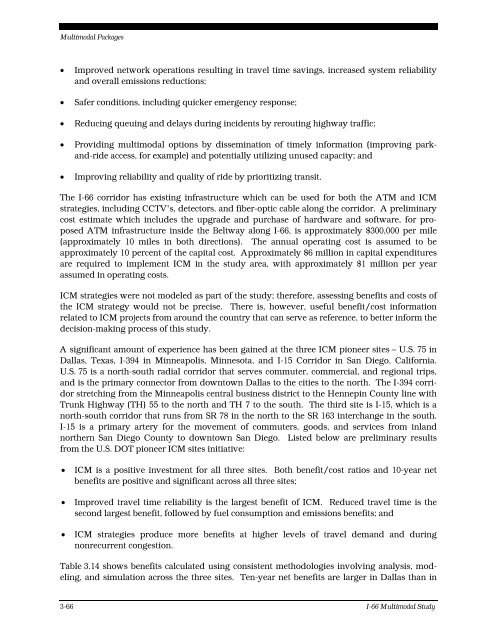I-66 Multimodal Study Final Report - Virginia Department of ...
I-66 Multimodal Study Final Report - Virginia Department of ...
I-66 Multimodal Study Final Report - Virginia Department of ...
- No tags were found...
You also want an ePaper? Increase the reach of your titles
YUMPU automatically turns print PDFs into web optimized ePapers that Google loves.
<strong>Multimodal</strong> PackagesImproved network operations resulting in travel time savings, increased system reliabilityand overall emissions reductions;Safer conditions, including quicker emergency response;Reducing queuing and delays during incidents by rerouting highway traffic;Providing multimodal options by dissemination <strong>of</strong> timely information (improving parkand-rideaccess, for example) and potentially utilizing unused capacity; andImproving reliability and quality <strong>of</strong> ride by prioritizing transit.The I-<strong>66</strong> corridor has existing infrastructure which can be used for both the ATM and ICMstrategies, including CCTV’s, detectors, and fiber-optic cable along the corridor. A preliminarycost estimate which includes the upgrade and purchase <strong>of</strong> hardware and s<strong>of</strong>tware, for proposedATM infrastructure inside the Beltway along I-<strong>66</strong>, is approximately $300,000 per mile(approximately 10 miles in both directions). The annual operating cost is assumed to beapproximately 10 percent <strong>of</strong> the capital cost. Approximately $6 million in capital expendituresare required to implement ICM in the study area, with approximately $1 million per yearassumed in operating costs.ICM strategies were not modeled as part <strong>of</strong> the study; therefore, assessing benefits and costs <strong>of</strong>the ICM strategy would not be precise. There is, however, useful benefit/cost informationrelated to ICM projects from around the country that can serve as reference, to better inform thedecision-making process <strong>of</strong> this study.A significant amount <strong>of</strong> experience has been gained at the three ICM pioneer sites – U.S. 75 inDallas, Texas, I-394 in Minneapolis, Minnesota, and I-15 Corridor in San Diego, California.U.S. 75 is a north-south radial corridor that serves commuter, commercial, and regional trips,and is the primary connector from downtown Dallas to the cities to the north. The I-394 corridorstretching from the Minneapolis central business district to the Hennepin County line withTrunk Highway (TH) 55 to the north and TH 7 to the south. The third site is I-15, which is anorth-south corridor that runs from SR 78 in the north to the SR 163 interchange in the south.I-15 is a primary artery for the movement <strong>of</strong> commuters, goods, and services from inlandnorthern San Diego County to downtown San Diego. Listed below are preliminary resultsfrom the U.S. DOT pioneer ICM sites initiative:ICM is a positive investment for all three sites. Both benefit/cost ratios and 10-year netbenefits are positive and significant across all three sites;Improved travel time reliability is the largest benefit <strong>of</strong> ICM. Reduced travel time is thesecond largest benefit, followed by fuel consumption and emissions benefits; andICM strategies produce more benefits at higher levels <strong>of</strong> travel demand and duringnonrecurrent congestion.Table 3.14 shows benefits calculated using consistent methodologies involving analysis, modeling,and simulation across the three sites. Ten-year net benefits are larger in Dallas than in3-<strong>66</strong> I-<strong>66</strong> <strong>Multimodal</strong> <strong>Study</strong>
















